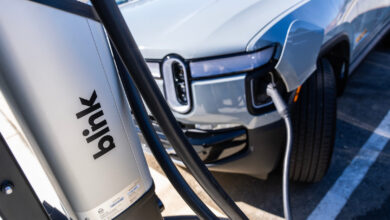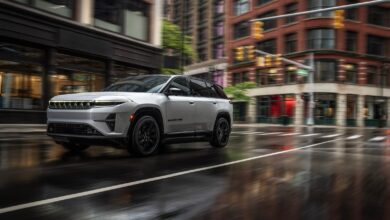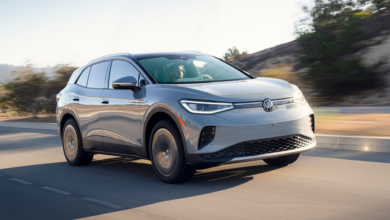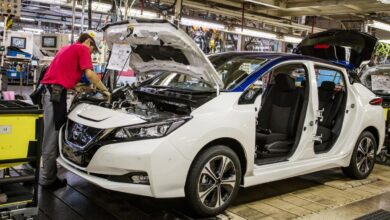Electric vehicle caravan hits the city |
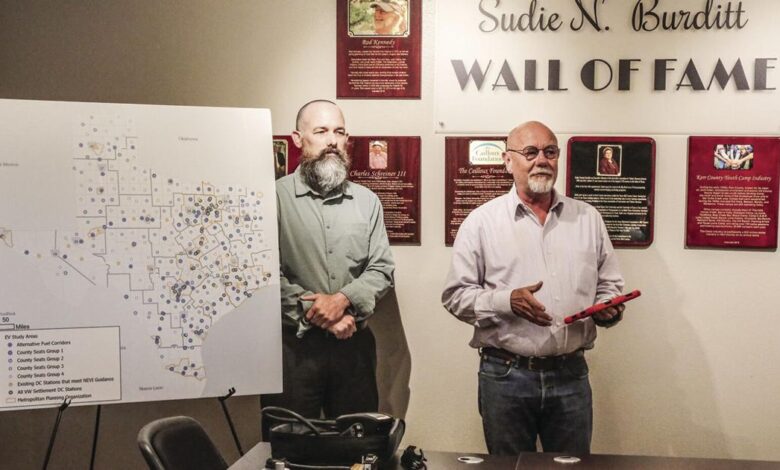
The challenge facing Texas and the rest of the U.S. in the coming years is slated to be the transition from gas or diesel-powered vehicles of all types to electric powered vehicles (EV). Supporters of electric vehicles admit that support for the transition from fossil fuels to electricity is not popular in many states, but believe it is the future of transportation in America.
Representatives of the Texas Electric Transportation Resources Alliance, the Texas Electric School Bus Project and the Texas Department of Transportation were in Kerrville last Wednesday morning as part of the “Electrify Texas: The South Texas EV Roadshow” with a fleet of electric vehicles to make a presentation about the growing electric vehicle market. They also provided information about tax incentives for individuals plus grant opportunities that local government entities and school districts who may want to convert to electric vehicles can apply for.
Unfortunately, none of the local government officials or school transportation officials who were invited were able to attend the event at the Kerrville Convention and Visitors Bureau offices. Representatives from the Kerrville Public Utility Board and local business owner Dalton Dover who owns NAPA Auto stores in Kerrville and Ingram were in attendance in addition to the press and local EV owners.
“The tour aims to inform South Texas leaders and stakeholders about electric transportation resources and encourage applications for available grants and incentives. TxDot will provide an update on the Texas EV plan,” said Amanda Alandzes in a news release from TxETRA.
During the press conference Buzz Smith, co-executive director of TxEXTRA explained that this was the third such tour the group has made in Texas. They began their tour in Corpus Christi and traveled to Brownsville and Laredo before coming to Kerrville and then on to San Antonio.
“Bringing the EV roadshow to these cities follows two successful EV road trips in West and East Texas and is a pivotal move for our electric transportation future. We are showing a diverse array of electric vehicles, including an electric school bus, and providing a comprehensive guide for electrifying Texas. Our goal is to invigorate local communities, collaborate with community stakeholders, and amplify the benefits of electric transportation, sparking progress in South Texas communities,” Smith said. The electric school bus was not a part of the group of vehicles that came to Kerrville, but was available during the group’s presentations in the other cities.
Michael Chamberlain from TxDot showed a map of the proposed locations for charging stations throughout the state of Texas funded by the federal EV infrastructure legislation passed by Congress and signed by President Biden. The legislation provides funding for the installation of the charging stations along interstate highways every 50 miles in Texas initially and eventually all over the state at locations in the county seat of each county and at various businesses in communities.
Smith explained that Tesla Automotive was now the largest employer in Austin and that the popularity of EVs in Texas was growing, despite negative stories in the press. Tesla recently changed its policy and now allows any EV to use Tesla charging ports that are already located in many areas of Texas.
Kerrville currently has one Level 3 charging station at the Kerrville CVB location on Sidney Baker North and several other Level 2 stations located around the community. The Level 3 station charges faster than the Level 2.
“We wanted to share our EV experience with Texans. There are currently over 270,000 electric vehicles (of 23 million total vehicles) on Texas roads and the number is growing by 50 percent each year,” Smith said.
He stressed that 95 percent of people who purchase EVs do not go back to gasoline or diesel powered vehicles because they are very pleased with their EVs and when time comes to replace, they will opt to buy another EV.
Smith predicted there will be 365,000 EVs on the roads in Texas by the end of 2024.
Electric vehicle manufacturing has added a lot of manufacturing jobs to the economy also, according to Smith.
In addition to the Tesla facility in Austin, there are several other manufacturing facilities in the state that produce the necessary parts for the vehicles and others under construction.
“That’s jobs and that’s prosperity for Texas,” Smith said. He also noted that people in some areas of Texas who have charging stations installed at their homes using solar panels are able to sell unused electricity to the state’s power grid and save money on their utility bills.
Michael Chamberlain, with the Texas Department of Transportation (TxDot), said that four-port charging stations (four chargers per location) will be installed along the interstate highways in Texas every 50 miles when the project is completed.
“The first construction will begin in May with 50 charging stations in Phase 1 and then Phase 2 will provide charging stations to be installed in all the county seats. People will be able to take whatever route they want to take to see grandma and there will be a charger there,” Chamberlain said.
Chamberlain said that TCEQ (Texas Commission on Environmental Quality) is also installing charging stations in metropolitan areas where pollution from gas-powered vehicles has become a larger problem, especially in the summer months.
He said of the seven million single-family homes in Texas today that 272,875 of the homes already have charging ports and the number will continue to increase as more EVs are sold, because the convenience of charging the vehicle at home is attractive to many EV owners.
Chamberlain said that the batteries used in current EVs have a 10 to 15-year life and provide about 300 miles per charge. The batteries are 99 percent recyclable.
Texas received the most federal money in the EV infrastructure legislation because of the size of the state.
“Each state had to put together a plan and submit it for funding. What a challenge for the state to create the plan,” Chamberlain said.
Laura Morrison who is a co-executive director of TxETRA said much of her time is spent on education and grants.
“We want to be sure that everyone understands and has access to electric vehicles. It’s better for the environment and better for our health. Although the initial cost of the vehicles are higher than conventional gas powered vehicles, EVs are cheaper to drive and have lower cost maintenance,” Morrison said.
“There are programs to assist people with financing to help them get into electric vehicles because it is good for improving air quality,” Morrison added.
She said the state of Texas has a grant program that provides $2,500 to EV purchasers, but all of that money had already been claimed for this biennium and no more will be available until after the 2025 Texas Legislature approves another state budget.
The federal government provides a $7,500 tax credit to buyers of EVs and the federal government also has grant money available to local government entities and school districts who convert to electric vehicles.
There is also a $100,000 rebate to entities who install fast-charging stations for multiple vehicles in a large fleet of EVs (like school buses or law enforcement vehicles), according to Morrison.
Morrison said the priority is transitioning school buses and transit buses away from diesel. The “Clean Bus Planning Award” program also provides technical assistance to school districts or transit authorities on how to tap into the funds that are available.
Jessica Keithan, co-founder and director of the Texas Electric School Bus Project, said Texas currently has an estimated 50,000 diesel-powered yellow school buses in school districts around the state.
“There’s a dark side to diesel buses. They produce noxious fumes that concentrate on the inside of the cabin of the bus,” Keithan said. She pointed out that the increase in the numbers of children with asthma or other breathing related problems may be tied to this issue.
“Switching to electric buses will be better for our kids, but also for our communities. It makes a ton of practical sense,” Keithan added.
“The future of electric buses will be a huge paradigm shift for school districts,” Keithan said. She also stressed that there is both federal and state funding available for school districts to transition to electric buses or it is possible to convert diesel buses to electric.
TxETRA program manager Mario Bravo stated that having a home charging station will give the EV owner a great opportunity to re-charge the vehicle overnight, if utility providers have electric rates that are traditionally lower at non-peak hours, which will save money for the homeowner.
“The charging infrastructure is coming. With an electric car you can get anywhere you want to go unless it’s an extended trip,” Bravo said.
To conclude the news conference Buzz Smith added that many people are now wanting to move away from the hustle and bustle of the big cities and return to the rural areas.
“Recharge stations need to be located near restaurants or coffee shops, so during the 30-minute charge time people have a place to wait. There is economic opportunity for small businesses in the area around the charging stations,” Smith said.
“If you do it right, it will become an economic boom. The charging stations will create a network. There were 140 installed in Texas last year and 74 the year before,” Smith added.
He explained also that people will need to learn the procedure for charging the EVs properly and how to safely drive. He advised that the EVs needed only to be charged to 80 percent because the last 20 percent took the longest time, and people could get where they wanted to go easily with only the 80-percent charge.
“For most EVs it takes 10 minutes to charge to 80 percent capacity at a Level 3 charging station,” he added. Dalton Dover, owner of the two local NAPA Auto stores also advised that the replacement adapters needed for the EVs are available locally at both of his stores.
Smith predicted places like Kerrville and other Hill Country communities, will see people who want to come here and to move here and that EVs are the future of Texas in the 21st Century.
